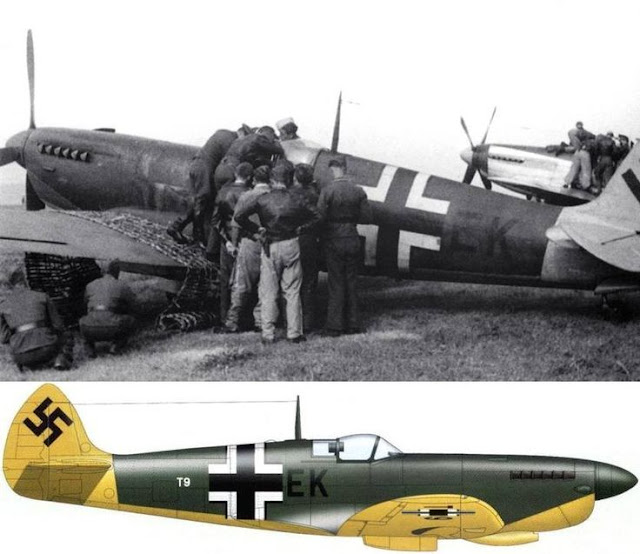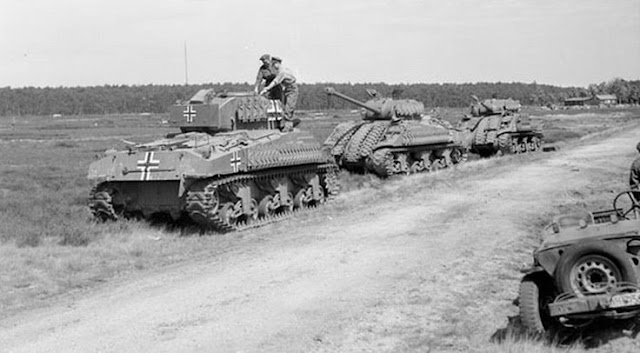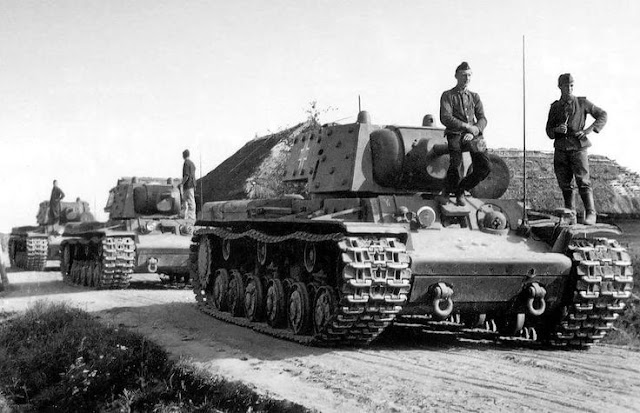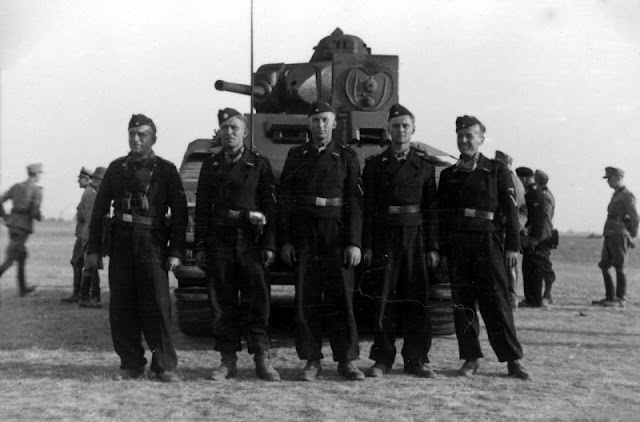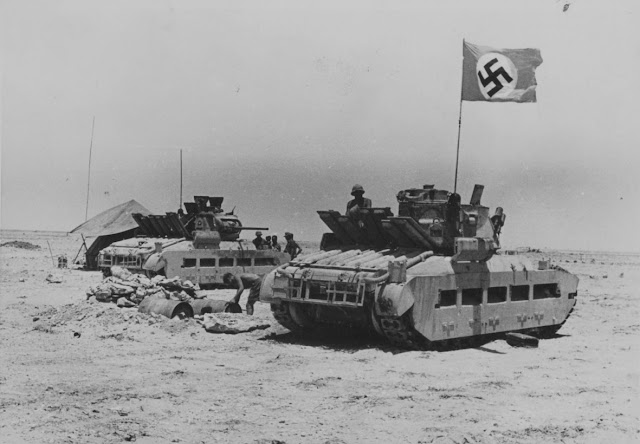Death at Sea
 |
| I don't know if this shot is genuine or not. |
This is reprinted from
Naval History and Heritage Command. Casual readers may not run across it there, but it deserves to be read, so here it is. My USAAF father had Nuclear Clearance at the time, which was uncommon, and worked on peripheral matters related to the Manhattan Project. Thus, this incident is of particular interest to me.
Oral History -The Sinking of USS Indianapolis (CA-35)
Recollections of the sinking of
USS Indianapolis (CA-35) by CAPT Lewis L. Haynes, MC (Medical Corps) (Ret.), the senior medical officer on board the ship.
[Original Source: Haynes, Lewis L. "Survivor of the Indianapolis." Navy Medicine 86, no.4 (Jul.-Aug. 1995): 13-17.]
Delivering the [Atomic] Bomb
After our repairs were completed, we were supposed to go on our post-repair trial run. But instead, on July 15th, we were ordered to go to San Francisco to take on some cargo. I was amazed to notice that there was a quiet, almost dead Navy Yard. We tied up at the dock there and two big trucks came alongside. The big crate on one truck was put in the port hanger. The other truck had a bunch of men aboard, including two Army officers, CAPT [James F.] Nolan and MAJ [Robert R.] Furman. I found out later that Nolan was a medical officer. I don't know what his job was, probably to monitor radiation. The two men carried a canister, about 3 feet by 4 feet tall, up to ADM Spruance's cabin where they welded it to the deck. Later on, I found out that this held the nuclear ingredients for the bomb and the large box in the hanger contained the device for firing the bomb. And I had that thing welded to the deck above me for 10 days!
 |
| The cargo of the USS Indianapolis. |
As we got underway on July 16th, CAPT McVay told his staff we were on a special mission. "I can't tell you what the mission is. I don't know myself but I've been told that every day we take off the trip is a day off the war." CAPT McVay told us his orders were that if we had an "abandon ship," what was in the admiral's cabin was to be placed in a boat before anybody else. We had all kinds of guesses as to what the cargo was.
 |
| Rear Admiral Charles Butler McVay III (July 30, 1898 – November 6, 1968) was the Commanding Officer of the USS Indianapolis (CA-35) when it was lost in action. He was the only commanding officer of a warship in the history of the U.S. Navy court-martialed for negligence resulting in the loss of his ship during wartime. |
After refueling at an eerily quiet Pearl Harbor, we made a straight run to Tinian at as much speed as they could economically go, about 25 or 26 knots. Everybody was at Condition Able which was 4 hours on and 4 hours off. It was like going into battle the whole way out. The trip from San Francisco to Tinian took a total of 10 days.
 |
| The B-29 base at Tinian. |
When we unloaded our special cargo at Tinian I noticed a couple of general Air Force officers handling these crates like they were a bunch of stevedores. I was even more sure we had something important.
 |
| Admirals King, Nimitz, and Spruance aboard USS Indianapolis,18 Jul 1944. |
We were then ordered to the Philippines for training exercises preparing for the invasion of Kyushu. CAPT McVay asked for an escort but was told we didn't need one as it was supposedly safe to go to the Philippines. What he wasn't told was that there were Japanese submarines along the way and that Naval Intelligence knew it.
Torpedo Hit
On July 29th I was pretty tired because I had given the whole crew cholera shots all day. I remember walking through the warrant officer's quarters and declining to join a poker game as I was so tired. I then went to bed.
 |
| I-58, which sank the Indianapolis. |
I awoke. I was in the air. I saw a bright light before I felt the concussion of the explosion that threw me up in the air almost to the overhead. A torpedo had detonated under my room. I hit the edge of the bunk, hit the deck, and stood up. Then the second explosion knocked me down again. As I landed on the deck I thought, "I've got to get the hell out of here!" I grabbed my life jacket and started to go out the door. My room was already on fire.
 |
| Japanese Lt. Cdr. Mochitsura Hashimoto at the periscope of his submarine, the 1-58, which was responsible for the sinking of the USS Indianapolis. |
I emerged to see my neighbor Ken Stout. He said, "Let's go," and stepped ahead of me into the main passageway. I was very close to him when he yelled, "Look out!" and threw his hands up. I lifted the life jacket in front of my face and stepped back. As I did, a wall of fire went "Whoosh!" It burned my hair off, burned my face, and the back of my hands. That's the last I saw of Ken.
I started out trying to go to the forward ladder to go up on the fo'c'sle deck, There was a lot of fire coming up through the deck right in front of the dentist's room. That's when I realized I couldn't go forward and turned to go aft. As I did, I slipped and fell, landing on my hands. I got third-degree burns on my hands -- my palms and all the tips of my fingers. I still have the scars. I was barefooted and the soles of my feet were burned off.
Then I turned aft to go back through the wardroom. I would have to go through the wardroom and down a long passageway to the quarterdeck, but there was a terrible hazy smoke with a peculiar odor. I couldn't breathe and got lost in the wardroom. I kept bumping into furniture and finally fell into this big easy chair. I felt so comfortable. I knew I was dying but I really didn't care.
Then someone standing over me said, "My God, I'm fainting!" and he fell on me. Evidently, that gave me a shot of adrenalin and I forced my way up and out. Somebody was yelling, "Open a porthole!" All power was out and it was just a red haze.
The ship was beginning to list and I moved to that side of the ship. I found a porthole already open. Two other guys had gone out through it. I stuck my head out the porthole, gulping in some air, and found they had left a rope dangling. I looked down to see the water rushing into the ship beneath me. I thought about going out the porthole into the ocean but I knew I couldn't go in there.
 |
| In memory of Paul T. Marple, Ensign, who lost his life aboard the USS Indianapolis. |
Instead, I grabbed the rope which was attached to an overhanging floater net. I pulled myself through the porthole and up to the deck above. I then went to my battle station, which was the port hanger. My chief, [CPhM John A.] Shmueck, and a lot of casualties were back there. I think the moon was going in and out because at times I could see clearly, other times not. We were trying to put dressings and give morphine to badly burned men when an officer came up and said, "Doctor, you'd better get life jackets on your patients."
So Shmueck and I went up a ladder to the deck above where there were some life jackets. We got a whole bunch of life jackets and went back down and started to put them on the patients. I remember helping a warrant officer. His skin was hanging in shreds and he was yelling, "Don't touch me, don't touch me." I kept telling him we had to get the jacket on. I was putting the jacket on when the ship tipped right over. He just slid away from me. The patients and the plane on the catapult all went down in a big, tangling crash to the other side. I grabbed the lifeline and climbed through to avoid falling. And by the time I did, the ship was on its side. Those men probably all died as the plane came down on top of them. All the rescue gear and everything we had out went down patients and everything together.
Into the Water
I slowly walked down the side of the ship. Another kid came and said he didn't have a jacket. I had an extra jacket and he put it on. We both jumped into the water which was covered with fuel oil. I wasn't alone in the water. The hull was covered with people climbing down.
I didn't want to get sucked down with the ship so I kicked my feet to get away. And then the ship rose up high. I thought it was going to come down and crush me. The ship kept leaning out away from me, the aft end rising up and leaning over as it stood up on its nose. The ship was still going forward at probably 3 or 4 knots. When it finally sank, it was over a hundred yards from me. Most of the survivors were strung out anywhere from half a mile to a mile behind the ship.
 |
| Garland Rich, lost at sea when the USS Indianapolis (CA-35) sank on July 30, 1945. |
Suddenly the ship was gone and it was very quiet. It had only been 12 minutes since the torpedoes hit. We started to gather together. Being in the water wasn't an unpleasant experience except that the black fuel oil got in your nose and eyes. We all looked the same, black oil all over -- white eyes and red mouths. You couldn't tell the doctor from the boot seamen. Soon everyone had swallowed fuel oil and gotten sick. Then everyone began vomiting.
At that time, I could have hidden but somebody yelled, "Is the doctor there?" And I made myself known. From that point on -- and that's probably why I'm here today -- I was kept so busy I had to keep going. But without any equipment, from that point on I became a coroner.
A lot of men were without life jackets. The kapok life jacket is designed with a space in the back. Those who had life jackets that were injured, you could put your arm through that space and pull them up on your hip and keep them out of the water. And the men were very good about doing this, Furthermore, those with jackets supported men without jackets. They held on the back of them, put their arms through there and held on floating in tandem.
 |
| Vincent Fast Horse, Lost at Sea, USS Indianapolis. He attended Red Cloud School which is on the Lakota Sioux Reservation. |
When daylight came we began to get ourselves organized into a group and the leaders began to come out. When first light came we had between three and four hundred men in our group. I would guess that probably seven or eight hundred men made it out of the ship. I began to find the wounded and dead. The only way I could tell they were dead was to put my finger in their eye. If their pupils were dilated and they didn't blink I assumed they were dead. We would then laboriously take off their life jacket and give it to men who didn't have jackets. In the beginning, I took off their dog tags, said The Lord's Prayer, and let them go. Eventually, I got such an armful of dog tags I couldn't hold them any longer. Even today, when I try to say The Lord's Prayer or hear it, I simply lose it.
Later, when the sun came up the covering of oil was a help. It kept us from burning. But it also reflected off the fuel oil and was like a searchlight in your eyes that you couldn't get away from. So I had all the men tie strips of their clothing around their eyes to keep the sun out.
 |
| Lt. Thomas Conway says mass on the USS Indianapolis. See the next photo. |
The second night, which was Monday night, we had all the men put their arms through the life jacket of the man in front of him and we made a big mass so we could stay together. We kept the wounded and those who were sickest in the center of the pack and that was my territory. Some of the men could doze off and sleep for a few minutes. The next day we found a life ring. I could put one very sick man across it to support him.
 |
| Lt. Thomas Michael Conway, a Catholic priest from Buffalo, New York a heroic chaplain who died while ministering to sailors in shark-infested waters after their ship was torpedoed during World War II. The U.S. Navy recently rejected awarding him a posthumous Navy Cross medal. |
There was nothing I could do but give advice, bury the dead, save the life jackets, and try to keep the men from drinking the saltwater when we drifted out of the fuel oil. When the hot sun came out and we were in this crystal clear water, you were so thirsty you couldn't believe it wasn't good enough to drink. I had a hard time convincing the men that they shouldn't drink. The real young ones -- you take away their hope, you take away their water and food -- they would drink salt water and then would go fast. I can remember striking men who were drinking water to try and stop them. They would get diarrhea, then get more dehydrated, then become very maniacal.
In the beginning, we tried to hold them and support them while they were thrashing around. And then we found we were losing a good man to get rid of one who had been bad and drank. As terrible as it may sound, towards the end when they did this, we shoved them away from the pack because we had to.
The water in that part of the Pacific was warm and good for swimming. But body temperature is over 98 and when you immerse someone up to their chin in that water for a couple of days, you're going to chill him down. So at night, we would tie everyone close together to stay warm. But they still had severe chills which led to fever and delirium. On Tuesday night some guy began yelling,
"There's a Jap here and he's trying to kill me." And then everybody started to fight. They were totally out of their minds. A lot of men were killed that night. A lot of men drowned. Overnight everybody untied themselves and got scattered in all directions. But you couldn't blame the men. It was mass hysteria. You became wary of everyone. Till daylight came, you weren't sure. When we got back together the next day there was a hell of a lot fewer.
 |
| William Gerald Nugent (lost aboard the USS Indianapolis). |
There were also mass hallucinations. It was amazing how everyone would see the same thing. One would see something, then someone else would see it. One day everyone got in a long line. I said, "What are you doing?" Someone answered, "Doctor, there's an island up here just ahead of us. One of us can go ashore at a time and you can get 15 minutes sleep." They all saw the island. You couldn't convince them otherwise. Even I fought hallucinations off and on, but something always brought me back.

I saw only one shark. I remember reaching out trying to grab hold of him. I thought maybe it would be food. However, when night came, things would bump against you in the dark or brush against your leg and you would wonder what it was. But honestly, in the entire 110 hours I was in the water I did not see a man attacked by a shark. However, the destroyers that picked up the bodies afterward found a large number of those bodies. In the report I read 56 bodies were mutilated, Maybe the sharks were satisfied with the dead; they didn't have to bite the living.
Rescue
It was Thursday [2 Aug] when the plane spotted us. By then we were in very bad shape. The kapok life jacket becomes waterlogged. It's good for about 48 hours. We sunk lower down in the water and you had to think about keeping your face out of water. I knew we didn't have very long to go. The men were semi-comatose. We were all on the verge of dying when suddenly this plane flew over. I'm here today because someone on that plane had a sore neck. He went to fix the aerial and got a stiff neck and lay down in the blister underneath. While he was rubbing his neck he saw us.
The plane dropped life jackets with canisters of water but the canisters ruptured. Then a PBY [seaplane] showed up and dropped rubber life rafts. We put the sickest people aboard and the others hung around the side. I found a flask of water with a 1-ounce cup. I doled out the water, passing the cup down hand-to-hand. Not one man cheated and I know how thirsty they were.
 |
| Lt. Adrian Marks, a resident of Frankfort, Ind., was largely responsible for the rescue of 56 survivors of the cruiser USS Indianapolis. Marks is seen here, fourth from right, with the crew of his PBY Catalina. |
Towards the end of the day, just before dark, I found a kit for making freshwater out of saltwater. I tried to read the instructions, but couldn't make sense of it or get it to work right. My product tasted like saltwater and I didn't want to take a chance so I threw it into the ocean. I then went to pieces.
 |
| A PBY Catalina picking up men at sea. |
I watched the PBY circle and suddenly make an open-sea landing. This took an awful lot of guts. It hit, went back up in the air and splashed down again. I thought he'd crashed but he came taxiing back. I found out later he was taxiing around picking up the singles. If he hadn't done this, I don't think we would have survived. He stayed on the water during the night and turned his searchlight up into the sky so the Cecil J. Doyle (DE-368) could find us. The ship came right over and began picking us up.
 |
| USS Indianapolis - Survivors on the deck of the USS Bassett, rescue vessel. Shark attacks began with the sunrise of the first day and continued until the men were physically removed from the water, almost five days later. |
The Cecil J. Doyle had a big net down over the side. Some of the sailors came down the side of the netting and pulled our rafts alongside. They put a rope around me; we were too weak to climb up. When they tried to grab hold of me I remember saying, "I can get up!" But I couldn't. Two sailors dragged me down the passageway. By the wardroom pantry, someone gave me a glass of water with a mark on it and would only give me so much water. I drank and when I asked for more, he said that was all I could have this time. Then the skipper asked me what ship I was from. I told him we were what was left of the Indianapolis.
 |
| A survivor of the USS Indianapolis. |
The next thing I knew, I was sitting in a shower. I remember corpsmen or seamen cleaning off my wounds, trying to wash the oil from me and dress my burns. I remember trying to lick the water coming down from the shower. They put me in a bunk and I passed out for about 12 hours. I recall the first bowel movement I had after I was picked up, I passed fuel oil. The other fellows found the same thing.
The Cecil J. Doyle took us to Peleliu. We were taken ashore and put into hospital bunks. I remember they came in and got our vital statistics -- we had discarded our dogtags because they were heavy. They changed our dressings. Some of the men got IV's [intravenous solution], though I didn't, While there I began to eat a little and get some strength back.
 |
| 1963 article in Stag magazine about the USS Indianapolis. |
Then after 2 or 3 days at Peleliu, someone came in and said that I was going to Guam. The next thing I knew, they hauled me out on a stretcher and onto a hospital ship.
 |
| Captain Bartholomew. |
The commanding officer of the ship, a friend of mine, was Bart [Bartholomew, Surgeon General of the Navy, 1955-1959] Hogan. Bart came in and said, "I know you don't feel well but you're going to have to go before the Inspector General. I'm going to send a corpsman in and I want you to start at the beginning and dictate everything you can remember about what happened because as time goes on you're going to forget and things are going to change."
So I sat down and dictated off and on for 3 days on the way to Guam. When I'd get tired I'd fall asleep and then I'd wake up and he'd come back.
 |
| Known as the worst maritime disaster in U.S, Naval History. Survivors of the USS Indianapolis (Sunk by a Japanese Sub On July 30, 1945) are taken to medical aid on the island of Guam. Photo from Wikipedia Commons. |
When we landed, Bart gave me a copy of what I dictated and I took it when I went to the Inspector General's office. I told my story, answered their questions, and gave them this report unedited, saying, "Here it is. This is probably as accurate as I can be." And that document is the file at the Inspector General's office. All the people who wrote books about the Indianapolis used it.
Normally, I don't have nightmares. Last night, I didn't sleep well. And I won't sleep well tonight. But eventually, my mind will turn off and I'll be all right. It's like when I try to say The Lord's Prayer or I sit down and try to talk to somebody about it. I'm all right as long as I stay away from talking about individuals -- my friends... I was on that ship over a year and a half and we were all close friends and we'd been through a lot together and I knew their wives and their families. As a doctor, you get more intimate than normal.
 |
| Lyle Ummenhoffer, USS Indianapolis survivor. |
 |
| Memorial to USS Indianapolis Indianapolis, Indiana. |
2019


















































